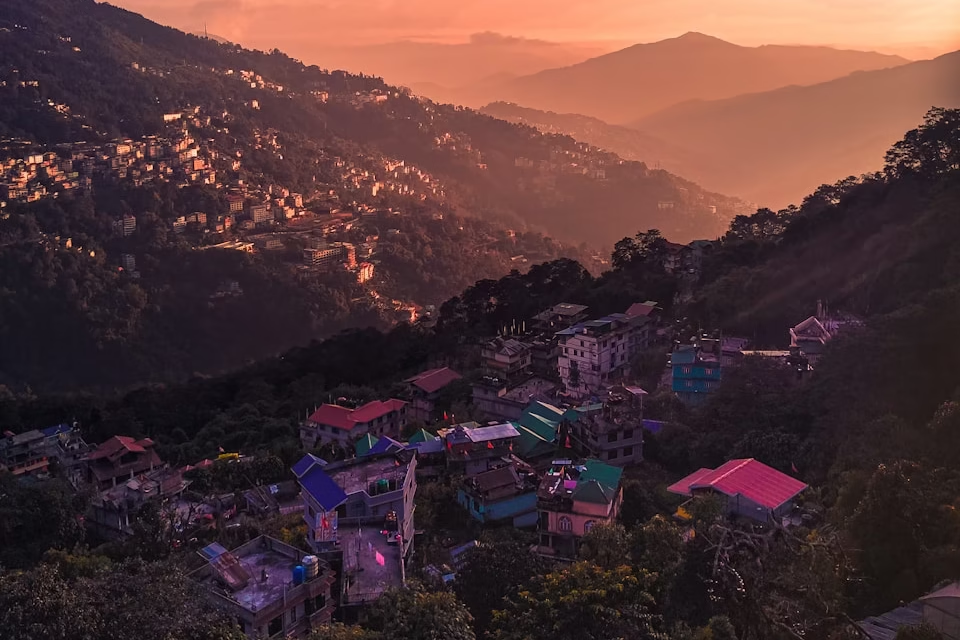Table of Contents

Peak Season: March to June and October to Mid-December
The best time to visit Sikkim is during two distinct periods: March to June (spring/summer) and October to mid-December (autumn/early winter). These months offer the most pleasant weather conditions with clear skies, moderate temperatures, and excellent visibility of the Himalayan peaks.
Spring/Summer Season (March-June)
Temperature Range: 5°C to 25°C
Spring is arguably the most spectacular best time to visit Sikkim, particularly for nature enthusiasts. During this period, the state transforms into a botanical paradise as rhododendrons burst into vibrant blooms across the valleys. The weather remains pleasant with warm, sunny days perfect for outdoor activities and sightseeing.
Key highlights of this season include:
- Rhododendron Festival: The valleys come alive with pink and red rhododendron blooms
- Clear mountain views: Excellent visibility of snow-capped peaks including Kanchenjunga
- Festival celebrations: Major Buddhist festivals like Saga Dawa and Buddha Jayanti occur during this time
- Perfect for adventure activities: Ideal conditions for trekking, paragliding, and river rafting
- Accessible high-altitude lakes: Snow-cleared roads facilitate visits to Tsomgo and Gurudongmar lakes
Autumn/Early Winter Season (October-Mid December)
Temperature Range: 4°C to 20°C
Autumn is considered by many as the absolute best time to visit Sikkim for those seeking crystal-clear mountain views. The post-monsoon period brings refreshing air, clear blue skies, and stunning panoramic vistas of the Himalayan range.
Advantages of visiting during autumn:
- Crystal-clear skies: Unobstructed views of the Himalayas, perfect for photography
- Pleasant weather: Crisp, cool air with comfortable temperatures
- Cultural festivals: Celebrations of Dashain, Tihar, and other regional festivals
- Excellent trekking conditions: Ideal weather for high-altitude treks
- Lower humidity: Dry, comfortable conditions after the monsoon season
Seasonal Weather Breakdown
Summer (March-June)
- Temperature: 5°C to 25°C
- Characteristics: Pleasant, moderate weather with occasional warm days
- Best for: Sightseeing, trekking, cultural festivals, and flower viewing
Monsoon (July-September)
- Temperature: 4°C to 17°C
- Rainfall: Heavy, with July being the wettest month
- Challenges: Risk of landslides, road blockages, and travel disruptions
- Advantages: Lush green landscapes, fewer crowds, lower accommodation prices
Winter (November-February)
- Temperature: -5°C to 7°C
- Characteristics: Cold temperatures, especially at higher altitudes
- Best for: Snow enthusiasts and experiencing winter festivals like Losar
- Challenges: Some high-altitude areas may be inaccessible due to heavy snowfall
Regional Considerations

North Sikkim
Best visiting months: May to September
- Temperature range: Maximum 28-30°C
- Special note: Winter conditions can be extremely harsh with sub-zero temperatures

East Sikkim (Including Gangtok)

West and South Sikkim
Travel Tips and Recommendations

What to Avoid
Monsoon season (July-September) is generally not recommended for first-time visitors due to:
- Heavy rainfall and potential flooding
- Frequent landslides disrupting travel
- Poor road conditions
- Limited visibility for mountain views
- Restricted outdoor activities
Best Activities by Season
Festival Calendar

Major festivals throughout the year:
- Maghe Sankranti: January 14
- Losar (Tibetan New Year): February-March
- Saga Dawa: April-May
- Drukpa Tseshi: July
- Pang Lhabsol: September
- Various Buddhist festivals: Throughout the year
Permit Requirements
- Indian citizens: No permits required for most areas, ILP needed for certain protected zones
- Foreign nationals: RAP (Restricted Area Permit) mandatory, PAP required for North Sikkim
Transportation and Accessibility

How to Reach Sikkim
- By Air: Pakyong Airport (32 km from Gangtok) or Bagdogra Airport (124 km from Gangtok)
- By Train: New Jalpaiguri (125 km) or Siliguri (114 km) are nearest railway stations
- By Road: Well-connected via National Highway 31A
Accommodation Options
Best time to visit Sikkim offers diverse accommodation ranging from luxury hotels to authentic homestays. Homestays are particularly popular, offering cultural immersion and local cuisine experiences.
Popular homestay areas:
- Gangtok and surrounding villages
- Pelling and West Sikkim
- North Sikkim villages
- Tea estate areas like Temi
The state’s culinary scene features a unique blend of Nepalese, Tibetan, and indigenous Sikkimese cuisine. Must-try dishes include momos, thukpa, phagshapa, and various fermented vegetables.
Best time to visit Sikkim
Best time to visit Sikkim, For the most rewarding Sikkim experience, plan your visit during March-June for blooming landscapes and cultural festivals, or October-December for the clearest mountain views and excellent trekking conditions. Both periods offer comfortable weather, good accessibility, and the full spectrum of Sikkim’s natural and cultural attractions.


1 thought on “Best Time to Visit Sikkim”